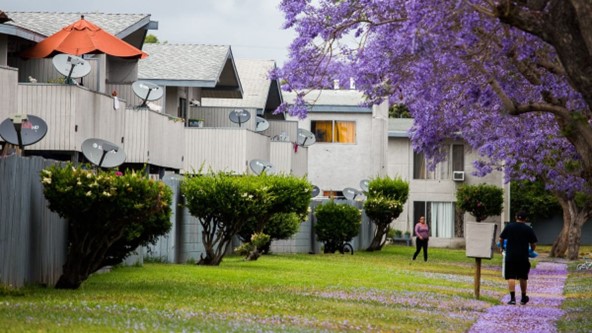BY BRANDON PHO May 17, 2023
 Apartment complexes in Santa Ana on May 18, 2020. Credit: JULIE LEOPO, Voice of OC
Apartment complexes in Santa Ana on May 18, 2020. Credit: JULIE LEOPO, Voice of OC
Officials in one of Orange County’s most progressive cities might be poised to exempt themselves from state housing mandates.
While neighboring towns like Huntington Beach have lambasted state homebuilding quotas – calling for more local control over the distant authority of Sacramento – Santa Ana has long touted being one of the few OC cities to be in compliance.
Yet even they might want out of the state’s directives.
And their signal drew immediate attention from state leaders this week.
On Tuesday, City Council members were slated to vote on a resolution excusing their town from two new housing bills out of the State Capitol – laws that streamline housing projects in office and retail areas and aim to combat a statewide housing affordability crisis.
Then came a letter from Attorney General Rob Bonta’s office, just hours before the scheduled vote.
“We urge you to continue this item to a later date so that affected and interested parties will have an adequate opportunity to review and comment on the proposal,” wrote Supervising Deputy Attorney General David Pai.
On Tuesday night, City Council members backed off.
For now.
They voted 5-2 to continue their discussion to the council’s June 20 meeting, at the advice of the city’s top attorney, Sonia Carvalho.
“I’m very confident in the City of Santa Ana and its support of housing and affordable housing, but based on some information we received I’d like to have the opportunity to review some letters and correspondence,” Carvalho said toward the start of the council’s regular meeting.
Not everyone agreed on the length of the vote’s delay, with council members Phil Bacerra and David Penaloza requesting it come back earlier, on June 6.
“Staff has a month to read a couple letters,” said Penaloza.
Reached for comment, a spokesperson for the agency that monitors local jurisdictions’ compliance with state housing quotas, Alicia Murillo, emailed the following statement:
“HCD [Housing and Community Development] is aware of the issue and cannot comment at this time.”
Both state laws at issue in Santa Ana – Assembly Bill 2011 and Senate Bill 6 – are set to take effect in July.
And both further restrict local land use controls, allowing housing units on parcels primarily used for commercial activity, regardless of whether a local city council supports them, wrote city staff in a report attached to Tuesday’s meeting.
Both laws also include provisions that allow local authorities to qualify for an exemption, provided they can reallocate it elsewhere.
City staff say they can, and put the exemption issue before council members on Tuesday for a vote that might have gone without public discussion.
Staff listed the item in the section of the meeting agenda that usually deals with routine contracts and noncontroversial city business.
Critics accused the city of trying to vote on a consequential city land use issue without public input measures like a city Planning Commission hearing.
In an emailed response to questions on Tuesday, City spokesperson Paul Eakins said “City Council resolutions regarding compliance with state law don’t need to go before the Planning Commission.”
“Also, Council resolutions don’t need to be placed on the City Council meeting Business Calendar, but like all Consent Calendar items, can be pulled by any City Councilmember for discussion and a separate vote.”
The city’s idea has support among residents like Dale Helvig, who helped mobilize resident opposition to a controversial apartments proposal at 2525 N. Main St. in the Park Santiago neighborhood.
The 256-unit project was criticized for a design that stood out from the rest of the neighborhood. A prior City Council approved it in 2020 despite resident protests, but it died later that year when residents organized a referendum, prompting enough council members to reverse their stance and the panel’s initial approval.
“No one is saying ‘Do not build at all’… merely build according to the State approved
General Plan and Housing Element,” Helvig wrote in an emailed letter to the council supporting their potential vote.
In a phone interview on Tuesday, he likewise cast the city’s message this way: “We’ll continue to develop, but we’re going to develop in areas that we feel are appropriate.”
City staff in their report note that Santa Ana’s one of just seven OC cities to have their Housing Element certified by the state.
“That new land use plan includes over 770 acres of land that were re-designated to allow residential density at or exceeding 30 dwelling units per acre, which is the threshold established and deemed appropriate by State law to accommodate housing for lower income households for jurisdictions in a metropolitan county,” staff wrote.
The Housing Element plans the for the city’s state-assigned construction quotas under the Regional Housing Needs Assessment, or RHNA.
“Santa Ana’s RHNA for the 6th Cycle is 3,137 units,” reads the staff report. “The City has already fulfilled 52 percent (1,635 units) of its 6th Cycle RHNA less than two years into the eight-year planning period. Moreover, the City exceeded its 5th Cycle (2014-2021 planning period) RHNA by over 2,400 percent.”
“City staff have waited until this late date to attempt to challenge these laws. Worse, they have ignored your Planning Commission, ignored council members and ignored the residents and ignored those of us who had worked hard and were visibly engaged in passing these bills,” wrote John Hannah, a representative for the Southwest Regional Council of Carpenters, in one letter.
In a phone interview before the meeting, Hannah — who’s also a Rancho Santiago Community College District Trustee — said AB 2011 contained key labor standards for construction workers of the would-be housing projects streamlined under the bill.
“Here’s a way that can ensure that the workers will be paid a prevailing wage,” Hannah said.
One of OC’s most high-profile homebuilding advocates, Elizabeth Hansburg, raised concern in one letter to the city with the precedent it would set, and wrote that the two state laws “are essential tools to help solve the housing shortage and affordability crisis and undermining them sends the wrong message.”
“Perhaps even worse, it creates a terrible precedent for more NIMBY cities to declare themselves exempt as well,” Hansburg wrote.

